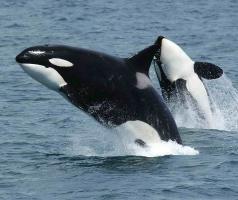 A study published in Nature’s Scientific Reports documents that as ferocious as great white sharks can be, even the great whites are afraid of transient orcas.
A study published in Nature’s Scientific Reports documents that as ferocious as great white sharks can be, even the great whites are afraid of transient orcas.
When the orcas swim by the Southeast Farallon Islands, off San Francisco, the great white sharks flee the area and often do not return for up to a year, even though the killer whales are typically just passing through. Both the sharks and the orcas feed on elephant seals indigenous to the Farallons. In addition to feasting on seals, the transient orcas have been known to attack and eat great while sharks. Rather than compete with the killer whales for the seals, and possibly end up as dinner themselves, the sharks choose another hunting ground.
The orcas are good news, relatively speaking, for the Farallon elephant seals. Because the orcas are transient and don’t stay long in the area, they eat fewer elephant seals than the resident great white sharks, who stay away longer than they need to, to make sure the orcas are gone.
Transient orcas are now often referred to as Bigg’s killer whales in honor of Canadian marine biologist Micheal Bigg, who is considered to be the founder of modern research on killer whales.
Bigg, who died in 1990, was the first to identify the difference between the two primary types of killer whales in the Pacific Northwest. One group of orcas, called residents, swam in well-defined pods, ate primarily fish and returned every year to the same area. Other orcas swam in smaller pods, ate primarily marine mammals and tended to be transient. Bigg observed that the residents and transients did not interact and had developed identifiable fin shapes and coloration. Many now consider the transient and resident orcas to be different species. Recent DNA analysis suggests that the last interaction between transients and residents took place roughly 700,000 years ago.
